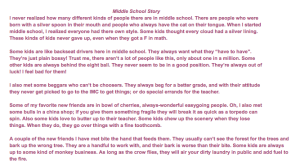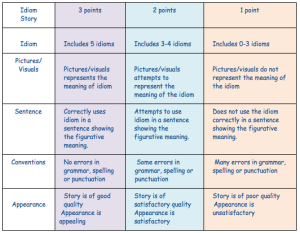Unit Objective
Students will be able to recognize and understand the meaning of idioms.
Students will be able to create their own idiom story using story jumper.
Students will be able to understand figurative and literal language
Students will be able to appreciate and value the use of idioms.
Background and Rationale
Idioms play an important social role. They provide a sense of camaraderie and friendship between people. Since idiomatic expressions are so frequently encountered in both the spoken and written discourse, they require special attention in language programs. The sheer number of idioms and their high frequency in conversation make them an important aspect of vocabulary acquisition and language learning in general. Knowing when and where to use them is an important social skill that should be an integral part of a language arts program. This particular lesson is imperative for my special education population of students because they struggle with figurative language. They often take things literally and do not understand the meaning and interpretations of idioms.
By developing a clear understanding of figurative language, students can further comprehend texts that contain metaphorical lexical meanings beyond the basic word level. In this lesson, students will explore figurative language with a focus on the literal versus the metaphorical translations of idioms. Through read-aloud, teacher modeling, and student- centered activities, students will further develop their understanding of figurative language.
Differentiation: Students will be exposed to a variety of materials in this lesson to keep them engaged. Students will have the opportunity, to listen, visualize, and expand upon creativity through written expression. The differentiation includes: Audio and Visual Cartoon; Flip Chart; Class discussion; Reinforcement Matching Activity; Skeletal Notes/Simplified Definitions; Drawings/Visuals; Exit Envelopes based on students’ ability; and Story Jumper
Lesson Objectives
Objective |
Bloom’s Verb |
|---|---|
|
Define the term “idiom” in written form with 100% accuracy. |
Remembering |
|
Compare Literal and Figurative language by completing a T-Chart in written form with 90% accuracy. |
Analyzing |
|
Discuss as a class common idioms create a list of ten idioms that may already be known and understood. |
Creating |
|
Recognize and identify the meaning of idioms by completing a matching activity given examples of idioms and their meanings with 80% accuracy. |
Understanding |
| Create an idiom story by incorporating at least five idioms and illustrations using Story Jumper. | Creating |
|
Orally present digital stories created in Story Jumper to the class with 80% accuracy. |
Remembering |
Bloom’s Taxonomy
Creating (highest level)
Common Core / State and District Standards
-
CCSS.ELA-Literacy.W.5.2 Write informative/explanatory texts to examine a topic and convey ideas and information clearly.
-
CCSS.ELA-Literacy.W.5.2.a Introduce a topic clearly, provide a general observation and focus, and group related information logically; include formatting (e.g., headings), illustrations, and multimedia when useful to aiding comprehension.
-
CCSS.ELA-Literacy.W.5.2.b Develop the topic with facts, definitions, concrete details, quotations, or other information and examples related to the topic.
-
CCSS.ELA-Literacy.W.5.2.c Link ideas within and across categories of information using words, phrases, and clauses (e.g., in contrast, especially).
-
CCSS.ELA-Literacy.W.5.2.d Use precise language and domain-specific vocabulary to inform about or explain the topic.
-
CCSS.ELA-Literacy.W.5.2.e Provide a concluding statement or section related to the information or explanation presented.
Learning and Innovation Skills (P21.org)
Creativity and innovation
Think Creatively:
-
Use a wide range of idea creation techniques (such as brainstorming)
-
Create new and worthwhile ideas (both incremental and radical concepts)
-
Elaborate, refine, analyze and evaluate their own ideas in order to improve and maximize creative efforts
Work Creatively with Others:
-
Develop, implement and communicate new ideas to others effectively
-
Be open and responsive to new and diverse perspectives; incorporate group input and feedback into the work
Reason Effectively:
-
Analyze how parts of a whole interact with each other to produce overall outcomes in complex systems
Make Judgments and Decisions
-
Effectively analyze and evaluate evidence, arguments, claims and beliefs
-
Analyze and evaluate major alternative points of view
-
Reflect critically on learning experiences and processes
Communicate Clearly
-
Articulate thoughts and ideas effectively using oral, written and nonverbal communication skills in a variety of forms and contexts
Collaborate with Others
-
Demonstrate ability to work effectively and respectfully with diverse teams
Life and Career Skills (P21.org)
Flexibility and Adaptability: Be Flexible
-
Incorporate feedback effectively
-
Deal positively with praise, setbacks and criticism
Initiative and Self Direction: Work Independently
-
Monitor, define, prioritize and complete tasks without direct oversight
Productivity and Accountability: Produce Results
-
Multi-task
-
Participate actively, as well as be reliable and punctual
-
Present oneself professionally and with proper etiquette
-
Collaborate and cooperate effectively with teams
-
Respect and appreciate team diversity
-
Be accountable for results
Information, Media, and Technology Skills (P21.org)
Create Media Products
-
Understand and utilize the most appropriate media creation tools, characteristics and conventions
Apply Technology Effectively
-
Use technology as a tool to research, organize, evaluate and communicate information
-
Use digital technologies (computers, PDAs, media players, GPS, etc.), communication/networking tools and social networks appropriately to access, manage, integrate, evaluate and create information to successfully function in a knowledge economy
Lesson – Introduction
Think-Puzzle-Explore will be the introduction to the lesson. This routine activates prior knowledge, generates ideas and curiosity and sets the stage for deeper inquiry. Do you THINK you know the topic? What questions or PUZZLES do you have? What does the topic make you want to EXPLORE?
Students will view a short YouTube video clip: Idiom Cartoon. The cartoon reveals characters that are having a conversation using a variety of idioms. After viewing the video, I will ask the students if they noticed anything about the phrases/words that were being used during the conversation. Students will jot down ideas on post-it notes and share them out as a group.
Do you THINK you know idioms?
I will ask students to draw upon their own personal experiences and background knowledge to discuss idioms and any others that they can think of. Prompting questions might include: Have you heard anyone in your family (like your parents or grandparents) use idioms when speaking? Which idioms do you use?
-
What questions or PUZZLES do you have about idioms? What would be interesting to learn more about? What are you wondering about? Are there things about this topic about which you are curious?
-
How can we EXPLORE these puzzles? Have students select a puzzle from their list. Share and discuss how one would explore the puzzles further. Ask: Whom might you ask? Where could you get more information? What would you key search words be? What could you do other than search for information? How could you find ways to answer your own puzzles?
This discussion will lead into the meaning of idioms and how they are used in figurative language. Implementing Think-Puzzle-Explore will help student take stock of what they already know and will push them to identify puzzling questions or areas of interest to peruse about figurative language (Ritchhart, 2011). This will allow me to get a good sense of where students are on a conceptual level and by returning to the routine of the course of the unit identify development and progress.
Lesson Activities and Procedures
Student Procedure |
Teacher Procedure |
Materials |
|---|---|---|
| Students will take skeletal notes from a Flip Chart presentation to provide a basic overview of idioms. | The teacher will share notes on idioms for a basic overview (15 min) |
|
|
Students will define the meaning of idioms and understand the difference between figurative and literal language by completing a graphic organizer T-Chart to form a deeper understanding of idioms. |
The teacher will demonstrate the difference between literal and figurative language by using a T-Chart and will lead the discussion of what idioms are by using guided questions. Students will interpret their own meaning of what an idiom is. (30 min) | Student Notes |
| Students will then complete a Matching Activity in pairs to reinforce idioms on the Promethean Whiteboard. Students will take turns using the interactive whiteboard. | The teacher will provide manipulatives to match for the students who are not at the board. (10 min) | Matching Cards |
|
Students will create their own short story using at least 5 idioms and incorporate images representation of the phrase in their story. |
The teacher will model this activity by using an example of a short story created using Story Jumper (15 min) |
|
|
Students will then create their own idiom story using Story Jumper. Students will be given a rubric that will clearly define the expectations for their story. |
The teacher will provide a rubric to follow as the students create their own idiom story using Story Jumper. (1 hr 30 min) | |
| The students will use their rubric to evaluate their story | The teacher will use the Idiom Story Rubric to evaluate the students’ stories. | Idiom Story Rubric |
Lesson Closure
Students will share what they have learned by completing an exit envelope. Each envelope will have differentiated questioned based on an idiom. All students will have to define what an idiom is and why we use them in our language. This is a formative assessment used to gauge students understanding of the lesson. If there are questions or concerns they will be addressed the following class. (5 minutes)
Assessment

Students will create their own story using Story Jumper. Included in the story the student must include at least five idioms with visual images. Students will be provided with a rubric that will clearly define the expectations of their idiom story. Students will present their story to the class.
Students will also be assessed through informal observation, on task behavior and oral questioning. Students are to remain on task and participate in all activities. Students will be formally assessed based on a teacher created rubric of student idiom story.
-
Matching Activity (Formative Assessment)
-
Exit cards: Each student will be given an idiom that they will have to describe in written form and write a sentence explaining why we use idioms in the English Language. (Formative Assessment) Exit Card
-
Rubric of for Student Created Idiom (Summative Assessment)
Assessment Rubric: Idiom Story Rubric
References: English Idioms Daily Blog. (2012, January 1). Retrieved August 3, 2014, from http://www.english-idioms.com/articles/files/tag-idiom-exercises-for-kids.html Ritchhart, R., Church, M., & Morrison, K. (2011). Making Thinking Visible: How to Promote Engagement, Understanding, and Independence for All Learners. San Francisco, CA: Jossey-Bass.



